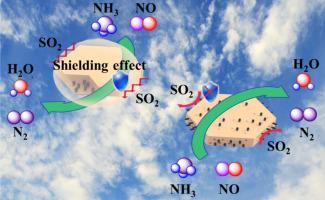当前位置:
X-MOL 学术
›
J. Hazard. Mater.
›
论文详情
Our official English website, www.x-mol.net, welcomes your
feedback! (Note: you will need to create a separate account there.)
Novel shielding and synergy effects of Mn-Ce oxides confined in mesoporous zeolite for low temperature selective catalytic reduction of NOx with enhanced SO2/H2O tolerance.
Journal of Hazardous Materials ( IF 12.2 ) Pub Date : 2020-04-13 , DOI: 10.1016/j.jhazmat.2020.122592 Ran Yan 1 , Sixue Lin 1 , Yonglong Li 1 , Wenming Liu 1 , Yangyang Mi 1 , Changjin Tang 2 , Liang Wang 3 , Peng Wu 4 , Honggen Peng 5
Journal of Hazardous Materials ( IF 12.2 ) Pub Date : 2020-04-13 , DOI: 10.1016/j.jhazmat.2020.122592 Ran Yan 1 , Sixue Lin 1 , Yonglong Li 1 , Wenming Liu 1 , Yangyang Mi 1 , Changjin Tang 2 , Liang Wang 3 , Peng Wu 4 , Honggen Peng 5
Affiliation

|
Nitrogen oxides (NOx) are a primary source of air pollutants from combustion of fossil fuels. Though Mn-Ce based catalysts exhibit superior low temperature activities, their water and SO2 tolerance is inferior to other metal oxide catalysts, due to their strong water adsorption and sulfate species formation tendency at low reaction temperatures. Herein, a confinement strategy was adopted to design and synthesize a novel Mn-Ce based catalyst for selective catalytic reduction of NOx with NH3. The confined MnCeOx catalyst was assembled with a simple one pot method, using a mesoporous zeolite (ZSM-5) as the shell and Mn-Ce oxides as the active core (MnCeOx@Z5). Owing to the zeolite shell's shielding effect and the synergy between the alumina-silica zeolite shell's acidic properties and the mixed oxide cores' redox properties, the novel MnCeOx@Z5 catalyst displayed enhanced water and SO2 resistance as compared to the MnCeOx supported on ZSM-5 (MnCeOx/Z5) and its precursor (MnCeOx@Al-SiO2). Evidently, the zeolite sheath hinders sulfate species formation, and this phenomenon was further investigated by in situ diffuse reflectance infrared Fourier transform spectroscopy (In situ DRIFTS). The novel shielding and acid-redox synergy effect/strategy adopted in this work can be applied to design other high performance deNOx catalysts for air pollution control.
中文翻译:

限制在介孔沸石中的Mn-Ce氧化物具有新颖的屏蔽作用和协同作用,可用于低温选择性催化还原NOx,具有增强的SO2 / H2O耐受性。
氮氧化物(NOx)是化石燃料燃烧产生的主要空气污染物。尽管Mn-Ce基催化剂表现出优异的低温活性,但是由于它们在低反应温度下的强水吸附性和形成硫酸盐物质的趋势,因此它们对水和SO 2的耐受性不如其他金属氧化物催化剂。在本文中,采用限制策略来设计和合成新型的Mn-Ce基催化剂,用于用NH3选择性催化还原NOx。使用中孔沸石(ZSM-5)作为壳层和Mn-Ce氧化物作为活性核(MnCeOx @ Z5),通过简单的一锅法组装受限的MnCeOx催化剂。由于沸石壳的屏蔽作用以及氧化铝-硅沸石壳的酸性和混合氧化物核的氧化还原特性之间的协同作用,与负载在ZSM-5(MnCeOx / Z5)及其前体(MnCeOx @ Al-SiO2)上的MnCeOx相比,新型MnCeOx @ Z5催化剂显示出更高的耐水和SO2性能。显然,沸石鞘阻碍了硫酸盐类的形成,并且通过原位漫反射红外傅里叶变换光谱法(Insitu DRIFTS)进一步研究了这种现象。在这项工作中采用的新颖的屏蔽和酸-氧化还原协同作用/策略可用于设计其他高性能的deNOx催化剂,以控制空气污染。并通过原位漫反射红外傅里叶变换光谱(Insitu DRIFTS)对该现象进行了进一步研究。在这项工作中采用的新颖的屏蔽和酸-氧化还原协同作用/策略可用于设计其他高性能的deNOx催化剂,以控制空气污染。并通过原位漫反射红外傅里叶变换光谱(Insitu DRIFTS)对该现象进行了进一步研究。在这项工作中采用的新颖的屏蔽和酸-氧化还原协同作用/策略可用于设计其他高性能的deNOx催化剂,以控制空气污染。
更新日期:2020-04-21
中文翻译:

限制在介孔沸石中的Mn-Ce氧化物具有新颖的屏蔽作用和协同作用,可用于低温选择性催化还原NOx,具有增强的SO2 / H2O耐受性。
氮氧化物(NOx)是化石燃料燃烧产生的主要空气污染物。尽管Mn-Ce基催化剂表现出优异的低温活性,但是由于它们在低反应温度下的强水吸附性和形成硫酸盐物质的趋势,因此它们对水和SO 2的耐受性不如其他金属氧化物催化剂。在本文中,采用限制策略来设计和合成新型的Mn-Ce基催化剂,用于用NH3选择性催化还原NOx。使用中孔沸石(ZSM-5)作为壳层和Mn-Ce氧化物作为活性核(MnCeOx @ Z5),通过简单的一锅法组装受限的MnCeOx催化剂。由于沸石壳的屏蔽作用以及氧化铝-硅沸石壳的酸性和混合氧化物核的氧化还原特性之间的协同作用,与负载在ZSM-5(MnCeOx / Z5)及其前体(MnCeOx @ Al-SiO2)上的MnCeOx相比,新型MnCeOx @ Z5催化剂显示出更高的耐水和SO2性能。显然,沸石鞘阻碍了硫酸盐类的形成,并且通过原位漫反射红外傅里叶变换光谱法(Insitu DRIFTS)进一步研究了这种现象。在这项工作中采用的新颖的屏蔽和酸-氧化还原协同作用/策略可用于设计其他高性能的deNOx催化剂,以控制空气污染。并通过原位漫反射红外傅里叶变换光谱(Insitu DRIFTS)对该现象进行了进一步研究。在这项工作中采用的新颖的屏蔽和酸-氧化还原协同作用/策略可用于设计其他高性能的deNOx催化剂,以控制空气污染。并通过原位漫反射红外傅里叶变换光谱(Insitu DRIFTS)对该现象进行了进一步研究。在这项工作中采用的新颖的屏蔽和酸-氧化还原协同作用/策略可用于设计其他高性能的deNOx催化剂,以控制空气污染。


















































 京公网安备 11010802027423号
京公网安备 11010802027423号